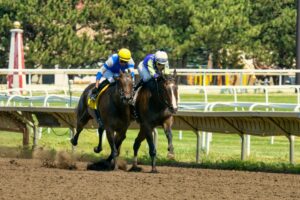Introduction to Horse Racing
Horse racing is one of the oldest and most prestigious sports in the world, with a history that traces back thousands of years. From ancient civilizations such as the Greeks and Romans, where racing was often part of religious festivals, to modern-day events held globally, horse racing has continually evolved, captivating audiences and participants alike. The sport encompasses various formats, including flat racing, jump racing, and harness racing, catering to a wide range of preferences and skills.
As it developed over the centuries, horse racing has grown from local events to international spectacles, drawing large crowds and significant media attention. The earliest recorded race took place in 255 BC, and it wasn’t long before competitive racing was formalized. The English established the first official racecourse in the 16th century, and since then, horse racing has become synonymous with tradition, showcasing the elegance and power of thoroughbreds.
The cultural significance of horse racing is vast, influencing fashion, social norms, and societal gatherings. Events such as the Kentucky Derby in the United States and The Grand National in the United Kingdom are not merely sporting occasions; they represent social events where tradition and high society intersect. This cultural impact extends further into the realm of betting and gambling, both of which have become integral components of the sport. The betting industry has capitalized on the excitement of horse racing, creating a multi-billion-dollar market that adds to the allure and engagement surrounding races.
Today, horse racing resonates with fans around the globe. Its impact on local economies, tourism, and community identity cannot be overstated. The sport not only entertains but also fosters connections among people who share a passion for equestrian excellence. As horse racing continues to transform, it remains a zealous blend of history, culture, and competition that endures through the ages.
The Kentucky Derby
The Kentucky Derby, often referred to as ‘The Most Exciting Two Minutes in Sports,’ is a prestigious horse racing event that has captivated audiences since its inception in 1875. Held annually on the first Saturday in May at Churchill Downs in Louisville, Kentucky, the Derby is the culminating feature of the Kentucky Derby Festival, which encompasses various festivities leading up to the race. As the longest-running sports event in the United States, it holds a special place in American culture, celebrating not just the sport of horse racing but also embodying a sense of tradition and community.
The race is famous for its rich history and distinctive customs, with one of the most iconic traditions being the sipping of the mint julep. This classic cocktail, made from bourbon, mint, and sugar, is closely associated with the Derby, as thousands of attendees indulge in this refreshing drink while enjoying the festivities. Moreover, the Derby is known as the ‘Run for the Roses’ due to the blanket of roses draped over the winning horse, symbolizing victory and excellence in the race.
The prelude to the Kentucky Derby features rigorous qualifying races for three-year-old thoroughbreds, culminating in a competitive field of the best horses. The event draws thousands of spectators, including celebrities and dignitaries, who gather to witness this extraordinary spectacle. The blend of excitement, fashion, and tradition creates an atmosphere unmatched in the world of sports. Beyond its immediate significance within horse racing, the Kentucky Derby represents a historical and cultural institution that captivates the collective imagination, making it a true highlight on the global sporting calendar.
The Grand National
The Grand National is widely recognized as the most famous steeplechase in the world, attracting horse racing enthusiasts and casual fans alike. Held annually at Aintree Racecourse near Liverpool, England, this event has rich historical roots dating back to its inception in 1839. The race is characterized by its challenging course, which spans approximately four miles and features 30 formidable obstacles, including iconic jumps such as Becher’s Brook and The Chair. This rigorous course tests both the horses’ stamina and the jockeys’ skill, making it a true spectacle of equestrian prowess.
Over the years, the Grand National has evolved into more than just a sporting event; it has become a significant part of British culture. Millions of viewers from around the globe tune in each year, transforming this race into a social occasion that brings together families and friends. In fact, it is common for individuals with little to no interest in horse racing to participate in office sweepstakes or place bets, adding to the race’s communal atmosphere. The appeal of the Grand National extends beyond the United Kingdom, capturing attention from international audiences who appreciate its storied history and thrilling nature.
Betting plays an integral role in the excitement surrounding the Grand National. It is one of the most wagered-upon events, with bookmakers showcasing a plethora of betting options. This practice not only enhances the experience for viewers but also contributes significantly to the economic impact of the event. The race’s profile continues to grow, attracting top-tier horses and jockeys from around the globe, solidifying its reputation as a premier event in the equestrian calendar. Through its unique combination of history, culture, and challenge, the Grand National remains a highlight in the world of horse racing.
The Melbourne Cup
The Melbourne Cup, held annually on the first Tuesday of November, is a quintessential event in the Australian sporting calendar, often referred to as “the race that stops a nation.” This prestigious horse race, which takes place at the iconic Flemington Racecourse in Melbourne, has a rich history that dates back to its inception in 1861. Originally a two-mile race, it has evolved over the years into a 3,200-meter race known for its excitement and unpredictability.
The significance of the Melbourne Cup extends far beyond the confines of the racetrack. It serves as a cultural touchstone for Australians, bringing together millions of people across the country who take a break from their daily lives to celebrate this remarkable event. The race day is marked by various traditions, including fashion parades, themed parties, and social gatherings, where spectators often dress in their finest attire. This annual spectacle includes both locals and international visitors, showcasing the global appeal of this celebrated race.
One of the most noteworthy aspects of the Melbourne Cup is its unique feature of international participation. Over the years, horses from various countries have entered the competition, contributing to its reputation as a premier horse racing event worldwide. Notable horses such as Green Moon, Makybe Diva, and more recently, Vow and Declare, have captured the hearts of fans and elevated the race’s prestige on the international stage. The event not only promotes thoroughbred racing but also supports industries surrounding hospitality, tourism, and local businesses, illustrating the Melbourne Cup’s significance in Australian society.
In conclusion, the Melbourne Cup stands out as a remarkable blend of tradition, culture, and competition, embodying the spirit of Australia and captivating the attention of a global audience. Its historical roots and contemporary significance ensure that it remains an enduring symbol of excellence in the world of horse racing.
The Prix de l’Arc de Triomphe
The Prix de l’Arc de Triomphe is often regarded as the pinnacle of European horse racing, celebrated for both its historical significance and the level of competition presented. Established in 1920, this prestigious race takes place at the Longchamp Racecourse in Paris, and has grown to become a focal point for elite thoroughbreds from around the globe. It is held annually on the first Sunday of October, drawing an international crowd of racing enthusiasts and participants alike.
One of the defining characteristics of the Prix de l’Arc de Triomphe is its challenging distance of 2,400 meters, a middle-distance race that tests the stamina and speed of each contender. This unique distance is tailored for horses capable of enduring high levels of exertion while maintaining a swift pace, making it a true test of horse racing pedigree. The race attracts top thoroughbreds from varied locales, including the best from Europe, Asia, and even further afield, creating an enticing mix of styles and strategies on the track.
Beyond the exhilarating actions on the racetrack, the Prix de l’Arc de Triomphe is synonymous with glamour and prestige. Longchamp Racecourse, famous for its luxurious facilities and vibrant atmosphere, provides a stunning backdrop for the event. Attendees not only come for the thrilling races but also to indulge in the fashions of the day, making it a social highlight within the sport. Owners, trainers, and jockeys often view winning this race as the pinnacle of their careers, enhancing its allure and global reputation.
As such, the Prix de l’Arc de Triomphe holds a unique place within the world of horse racing, representing a fusion of excellence, tradition, and celebration. Its status as Europe’s most prestigious horse race is only further solidified by the illustrious legacy of champions who have graced its track, each vying for honor and glory in this remarkable event.
The Preakness Stakes
The Preakness Stakes, held annually at Pimlico Race Course in Baltimore, Maryland, is the second leg of the esteemed Triple Crown of thoroughbred horse racing in the United States. This prestigious event typically takes place on the third Saturday in May, two weeks following the Kentucky Derby. Established in 1873, the Preakness has a rich history that adds to its allure and significance within the horse racing community.
One of the race’s most recognizable features is the iconic Black-Eyed Susan blanket, which is draped over the winning horse. This vivid yellow floral arrangement, made from cheerful black-eyed susan flowers, symbolizes the event and is a treasured tradition that connects generations of racing fans. The blanket’s design and the use of these flowers highlight the regional botanical characteristics and the cultural significance of the event itself.
The Preakness Stakes is not only a showcase of equestrian excellence but also a vibrant celebration of American culture and community spirit. The event draws thousands of spectators each year, who engage in festivities that extend beyond the races. From the excitement of the track to the exhilarating atmosphere saturated with fashion, food, and festivities, the Preakness is an occasion that resonates with both local attendees and visitors from around the world.
As competitors race down the stretch of Pimlico, the Preakness Stakes commands attention not only for its challenging course but also for its role in determining legacy among the greatest racehorses in history. Win, lose, or draw, the Preakness remains a fundamental part of the American horse racing landscape, celebrated for its past victories and anticipated future champions. In conclusion, it represents an essential chapter within the captivating narrative of equestrian sporting events.
The Belmont Stakes
The Belmont Stakes, often referred to as ‘The Test of the Champion,’ is one of the most prestigious horse races in the world. Held annually in Elmont, New York, at Belmont Park, this race is the third and final leg of the American Triple Crown, which also includes the Kentucky Derby and the Preakness Stakes. First contested in 1867, the Belmont Stakes has a storied history that showcases the evolution of thoroughbred racing in the United States.
One of the defining features of the Belmont Stakes is its distance. Spanning a formidable 1.5 miles, it is the longest race in the Triple Crown series. This extended distance not only tests the speed and agility of the horses but also their endurance and stamina, making it a true test of a champion. The unique challenges posed by the length often lead to unexpected outcomes, distinguishing the Belmont Stakes from its predecessors. Many horse racing enthusiasts consider this factor crucial in determining the ultimate champion, as only the most prepared and resilient horses can succeed in this grueling contest.
The Belmont Stakes holds particular significance for horses seeking the Triple Crown. Winning this race is pivotal for any horse that has triumphed in both the Kentucky Derby and the Preakness Stakes. With so much at stake, the pressure mounts for both the competitors and their connections. The atmosphere at Belmont Park during race day is charged with excitement, as fans gather to witness history being made. Over the years, legendary racehorses such as Secretariat and Affirmed have etched their names in the annals of racing through their Belmont victories, further solidifying the race’s reputation in the sport.
The Dubai World Cup
The Dubai World Cup, inaugurated in 1996, holds the prestigious title of being the richest horse race in the world, with a staggering purse that has often exceeded $12 million. This event takes place annually at the Meydan Racecourse in Dubai, contrasting its opulence with the traditional glamour of horse racing, helping to position the Middle East as a burgeoning hub for the sport. The first event was met with great anticipation and enthusiasm, and over the years, it has successfully attracted a global audience, drawing elite horses, renowned trainers, and accomplished jockeys from across the globe.
Since its inception, the Dubai World Cup has become synonymous with luxury. Events leading up to the race include gala dinners, fashion shows, and exclusive parties that create a vibrant social scene, drawing spectators and enthusiasts alike. This combination of sportsmanship and extravagance contributes to the allure of the event and enhances the overall experience for attendees. The race itself typically occurs on the last Saturday in March and has become a focal point for the UAE’s racing calendar. The glamour associated with the Dubai World Cup has indeed helped elevate the profile of horse racing in the region.
Notable competitors have graced this illustrious race, further solidifying its status in the sport’s history. Iconic horses such as Cigar and Curlin have made their mark, showcasing exceptional skill and prowess on the racetrack. The addition of significant international contenders has sparked fierce competition, enriching the narrative of the Dubai World Cup. With each passing year, the race continues to draw interest and admiration, establishing itself as a key event that cordially invites both equine excellence and lavish celebrations in the heart of the Middle East.
The Epsom Derby
The Epsom Derby, first run in 1780, is one of the oldest and most prestigious horse races in the world. This iconic 12-furlong flat race, held annually on the Epsom Downs in Surrey, England, is the centerpiece of the British horse racing calendar. It is part of the British Classic Races, a set of five races that highlight the country’s superb equine talent and long-standing racing heritage. Over the years, the Derby has witnessed unforgettable moments, showcasing the prowess of both horses and jockeys.
The unique challenges presented by the Epsom Downs course are significant. The track features a downhill start, followed by a steep rise at Tattenham Corner, testing the stamina and agility of participating horses. The undulating nature of the course, combined with its left-handed turns, creates a true test of both physical ability and strategic racing. This distinctive layout has led to the emergence of numerous legendary horses who have triumphed against these challenges, elevating their status in racing history.
The Epsom Derby is not merely a sporting event—it occupies a notable place in British social life. Traditionally, it attracts a diverse audience, ranging from racing enthusiasts to members of the upper class eager to partake in the social festivities surrounding the event. The atmosphere blends the excitement of horse racing with a social gathering, often accompanied by elegant attire and lavish picnics on the Downs. The race has been a launching pad for many standout thoroughbreds, making it an essential milestone in any aspiring racehorse’s career.
With its rich history, distinctive course, and substantial social significance, the Epsom Derby continues to be a highlight in the world of equestrian sports, celebrated by many as a symbol of excellence in horse racing.
The Breeders’ Cup
The Breeders’ Cup, inaugurated in 1984, has evolved into a pinnacle event in the world of Thoroughbred horse racing. This prestigious series comprises a collection of Grade One races, culminating in championship events that showcase the finest horses from around the globe. The Breeders’ Cup represents not only a celebration of superior equestrian talent but also an essential gathering for owners, trainers, and fans who share a passion for the sport.
From its inception, the Breeders’ Cup was designed to bring together the best horses and jockeys, thus creating opportunities to witness top-level competition. Races are held annually, typically in the fall, and span various distances and surfaces, reflecting a rich diversity in thoroughbred racing. The event often features traditional categories such as the Classic, Turf, and Sprint, each attracting elite equine athletes. The championship nature of the races determines breeding rights and market valuations, impacting the horse racing industry significantly.
The Breeders’ Cup has witnessed remarkable trends and notable statistics over the years, making it a significant fixture on the international racing calendar. Certain horses have left indelible marks on its history—horses like Zenyatta and Americans Pharaoh, who not only excelled in their respective races but also helped to elevate the event’s profile globally. Additionally, the introduction of new categories, like the Breeders’ Cup Juvenile, aimed at showcasing younger talent, has increasingly drawn attention and investment into the sport, fostering growth.
The importance of the Breeders’ Cup lies not only in its status as a championship but also as a celebration of the art of horse racing itself. The event serves as a vital platform for highlighting breeding excellence, equine performance, and the passion shared by everyone involved in this remarkable sport.




